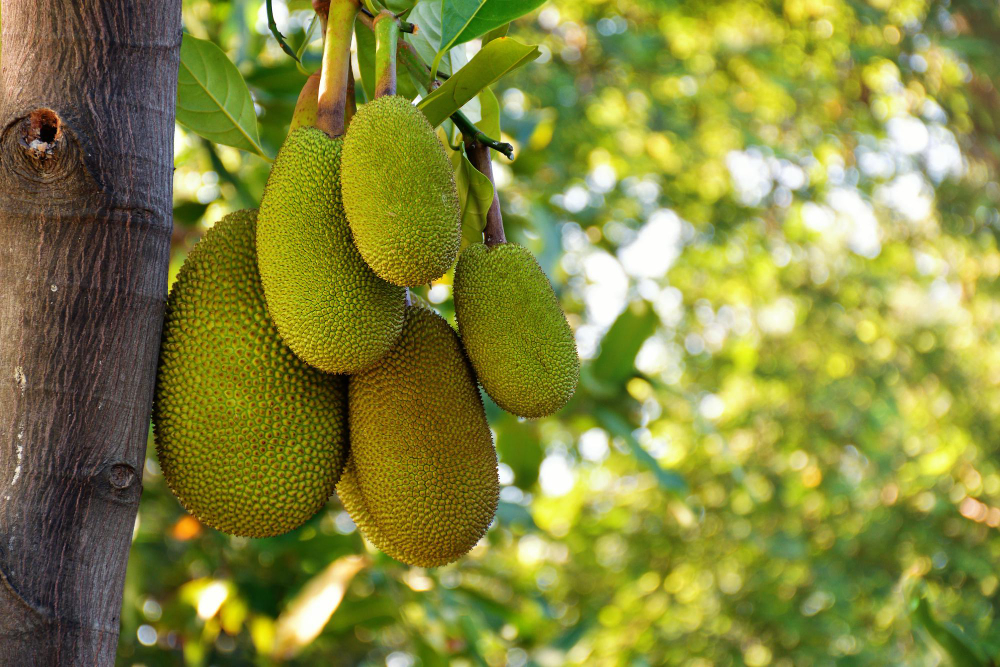Atulya Vanam's Mighty Jackfruit: Unraveling its Medicinal Marvels and Culinary Delights Across Healing Traditions
The Jackfruit tree (Artocarpus heterophyllus) stands as a symbol of abundance and versatility, offering not only its prized fruit but also a spectrum of therapeutic benefits through its leaves, fruit, bark, roots, and flowers.
In this comprehensive blog, we embark on a captivating journey to explore the diverse uses of the Jackfruit tree in an array of medical systems, including Modern Medicine, Ayurveda, Unani, Homeopathy, Siddha, and its multifaceted applications. Additionally, we delve into the diverse Jackfruit varieties found across India.
Medicinal Value
Fruit (Jackfruit): Beyond its sumptuous taste, the Jackfruit’s fruit boasts substantial nutritional content, including vitamins, minerals, and dietary fiber, promoting digestive health and overall well-being.
Seeds: Jackfruit seeds are valued for their protein content and potential antioxidant properties, contributing to modern health-conscious diets.
Ayurveda:
Fruit (Jackfruit): Ayurveda recognizes the Jackfruit’s sweet and unctuous qualities, often using it to pacify imbalanced vata dosha. It enhances vitality, promotes digestion, and balances the body.
Bark: The astringent properties of Jackfruit bark find application in Ayurvedic formulations to address conditions like diarrhea and dysentery.
Unani:
Fruit (Jackfruit): The Jackfruit’s nutritive attributes are valued in Unani medicine, potentially providing energy and supporting overall wellness.
Homeopathy:
Fruit (Jackfruit): While not a primary ingredient, Homeopathy may incorporate Jackfruit into remedies targeting specific symptoms or health concerns.
Siddha:
Fruit (Jackfruit): In Siddha medicine, the Jackfruit’s cooling essence is recognized, believed to support digestion and overall health.
General Uses
Culinary Excellence: The Jackfruit’s large and flavorful fruit is celebrated for its versatility in culinary creations, ranging from savory dishes to sweets and beverages.
Wood and Craftsmanship: The wood of the Jackfruit tree is used in crafting furniture, decorative items, and even musical instruments due to its sturdy nature.
Economic and Environmental Value: Jackfruit trees contribute to agroforestry systems, providing shade, preventing soil erosion, and supporting sustainable practices.
Jackfruit Varieties in India
Kathal: Known as “Kathal” in North India, this variety boasts a distinct taste and is frequently used in vegetarian dishes.
Varikka: Referred to as “Varikka” in South India, it’s valued for its large size and succulent flesh.
Koozha: Known as “Koozha,” this variety is cherished for its slightly fibrous texture and is commonly used in curries.
Cochin Jackfruit: Originating from Cochin, this variety offers a unique flavor and is often consumed ripe.
Rasal: Hailing from Maharashtra, “Rasal” Jackfruit is appreciated for its sweet flavor, making it a popular choice for desserts.



More about Jackfruit
Jackfruit trees (Artocarpus heterophyllus) are intriguing and unique trees with a range of extraordinary qualities. Here are some fascinating facts about jackfruit trees:
- Giant Fruits: Jackfruit trees produce the world’s largest tree-borne fruit, with some specimens weighing up to 80 pounds (36 kilograms) and measuring over 3 feet (90 centimeters) in length.
- Versatile Fruit: Jackfruit is known as a “miracle crop” due to its multiple uses. Its ripe flesh is enjoyed as a sweet and flavorful fruit, while the unripe flesh can be cooked and used as a meat substitute in savory dishes.
- Tropical Origin: Jackfruit trees are native to the rainforests of southwest India, and they are now cultivated in tropical regions around the world.
- Bountiful Harvest: A single jackfruit tree can yield a substantial harvest, providing both food and economic value to communities.
- Diverse Varieties: There are multiple jackfruit varieties, each with distinct flavors, textures, and sizes, ranging from sweet to mildly tangy.
- Culinary Versatility: The unripe jackfruit’s texture closely resembles pulled pork or shredded chicken when cooked, making it a popular choice for plant-based and vegetarian dishes.
- Nutritional Value: Jackfruit is rich in dietary fiber, vitamins (such as vitamin C and vitamin B6), and minerals (like potassium), contributing to its potential health benefits.
- Natural Sweetener: In some cultures, the ripe jackfruit is used as a natural sweetener due to its high sugar content and pleasant taste.
- Sustainable Crop: Jackfruit trees are environmentally friendly as they require fewer resources compared to livestock production for meat alternatives.
- Medicinal Uses: In traditional medicine, various parts of the jackfruit tree are used for their potential health benefits, including treating digestive issues and improving skin health.
- Wood and Timber: Beyond its fruit, the jackfruit tree’s timber is prized for its durability and is used in various woodworking applications.
- Fibrous Bast: The inner bark of the jackfruit tree, known as bast fiber, is used to make ropes, textiles, and traditional crafts.
- Artistic Inspiration: The unique appearance of the jackfruit’s outer surface has inspired artistic designs, patterns, and cultural motifs.
- Cultural Significance: In countries where it is grown, the jackfruit holds cultural importance and is often featured in traditional ceremonies and festivals.
- Growing Habitat: Jackfruit trees thrive in warm and humid climates. Their large leaves provide shade, making them suitable for agroforestry systems.
- Aesthetic Appeal: Jackfruit trees feature broad, dark-green leaves and unique oval-shaped fruits that add visual interest to tropical landscapes.
These extraordinary facts showcase the multifaceted nature of jackfruit trees, from their impressive fruit size to their culinary versatility, sustainable attributes, and cultural significance. The jackfruit tree’s role as both a source of nourishment and a sustainable solution reflects its significance in fostering food security and promoting environmentally conscious practices.
Conclusion
The Jackfruit tree, a manifestation of bounty and adaptability, surpasses its role as a mere fruit-bearer. Its leaves, bark, roots, flowers, and diverse applications interlace with a plethora of medical systems and cultural practices. From Ayurveda’s holistic wisdom to modern medical validation, the Jackfruit tree’s offerings flourish. By embracing the fusion of age-old knowledge and contemporary exploration, we uncover the countless ways in which the Jackfruit tree enhances our lives—nourishing not only our bodies but also our cultural heritage and environment.
